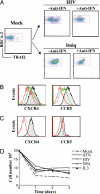HIV turns plasmacytoid dendritic cells (pDC) into TRAIL-expressing killer pDC and down-regulates HIV coreceptors by Toll-like receptor 7-induced IFN-alpha
- PMID: 17956986
- PMCID: PMC2077277
- DOI: 10.1073/pnas.0707244104
HIV turns plasmacytoid dendritic cells (pDC) into TRAIL-expressing killer pDC and down-regulates HIV coreceptors by Toll-like receptor 7-induced IFN-alpha
Abstract
Plasmacytoid dendritic cells (pDC) are key players in viral immunity and produce IFN-alpha after HIV-1 exposure, which in turn regulates TNF-related apoptosis-inducing ligand (TRAIL) expression by CD4(+) T cells. We show here that infectious and noninfectious HIV-1 virions induce activation of pDC into TRAIL-expressing IFN-producing killer pDC (IKpDC). IKpDC expressed high levels of activation markers (HLA-DR, CD80, CD83, and CD86) and the migration marker CCR7. Surprisingly, CXCR4 and CCR5 were down-regulated on IKpDC. We also show that HIV-1-induced IKpDC depended on Toll-like receptor 7 (TLR7) activation. HIV-1 or TLR7 agonistexposed IKpDC induced apoptosis of the CD4(+) T cell line SupT1 via the TRAIL pathway. Furthermore, IFN-alpha produced after HIV-induced TLR7 stimulation was responsible for TRAIL expression and the down-regulation of both CXCR4 and CCR5 by IKpDC. In contrast, activation and migration markers were not regulated by IFN-alpha. Finally, IFN-alpha increased the survival of IKpDC. We characterized a subset of pDC with a killer activity that is activated by endosomal-associated viral RNA and not by infection.
Conflict of interest statement
The authors declare no conflict of interest.
Figures




References
Publication types
MeSH terms
Substances
Grants and funding
LinkOut - more resources
Full Text Sources
Research Materials

